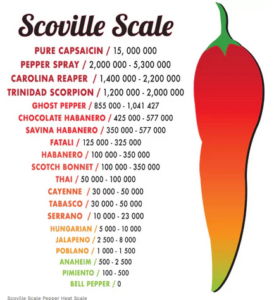No products in the cart.
Spiciness is a great and terrible thing. Sometimes, just a touch of it is enough to bring out new flavor profiles and sensations that bring you out of your comfort zone in a good way. Other times, it could lead to one of the most unpleasant moments of your life. Recently, we wrapped up filming one of our Mukbang videos where we ate some of the arguably most spicy noodles I had ever had. Needless to say, the experience was more akin to the latter than the former.
[img source: http://biologicalexceptions.blogspot.com/2014/03/maybe-we-do-taste-burn.html ]
I tried to look online for some potential remedies, but instead found out more information on peppers than you could repel an elephant with. Including how spiciness is measured, what causes the spiciness, and a list of the spiciest pepper species known to man.
[img source: https://www.mrfood.com/blog/mf/different-types-of-peppers-to-spice-things-up/ ]
Let’s begin with a little bit of food science. Spiciness, or pungency as it’s scientifically known, is caused by a chemical family called capsaicinoids. With the most well known of them being Capsaicin. Capsaicinoids are known as irritants and cause a burning sensation when it comes in contact with the heat and chemical nerve receptors on organic tissue. It is also found in certain plants, like peppers, as a chemical deterrent to mammals.
[img source: https://www.cayennediane.com/what-are-capsaicinoids/ ]
The measurement of peppers pungency is usually done on the Scoville Heat Scale. When I first learned about how the scale came to be, I was intrigued because of the fact that it is based on the subjective experiences of human judges as they tasted each new pepper. The origin story for the scale that I heard sounded almost cartoonish; the creator of the scale, pharmacist Wilbur Scoville, would have a test subject take a bite of a pepper, and then give the subject a number of sugar cubes until the heat had subsided. The number of sugar cubes needed to subdue the spiciness was to be that pepper’s Scoville rating.
[img source: https://ipfs.io/ipfs/QmXoypizjW3WknFiJnKLwHCnL72vedxjQkDDP1mXWo6uco/wiki/Scoville_scale.html]
The most expedient way to test is done with a panel of five trained tasters. A specific amount of dried pepper is placed in alcohol to draw out the capsaicin it contains, and then is diluted in sugar water at varying amounts. When three of the five tasters can no longer detect the heat, the diluted amount is used as the base rating on the Scoville Heat Scale.

[img source: normexgroup.com/blogs/blog-recipes/scoville-scale ]
Now that we have gone through the technical information, we can appreciate what it means to be the spiciest pepper in the world. As a baseline, I want to give you Scoville Heat Units (SHU) of some common spicy things that you may come across in your daily life. Tabasco Sauce ranks at 2,000 SHU, El Yucateco at around 5,800SHU, and Sriracha topping out at 8,000 SHU. With those sauces as a frame of reference, here are the 5 spiciest peppers in the world!
[img source: http://dish.allrecipes.com/choosing-chile-peppers/ ]
Trinidad Scorpion Butch T
This was the Guiness book of Records hottest pepper in 2011. It is a member of the Scotch Bonnet pepper family and its name derives from the narrow pointed “tail” at the bottom of the fruit. Its Scoville heat rating peaks at around 1.46 million SHU.
[img source: https://www.sandiaseed.com/products/trinidad-scorpion ]
7 Pot Primo
This pepper is a crossbreed of the Naga Morich and Trinidad 7 Pot pepper and is one of the more stable varieties of super spicy peppers. The surface is quite bumpy and aside from it’s signature red color, it comes in yellow and orange as well. Its Scoville heat rating peaks at around 1.47 million SHU.
[img source: https://www.sandiaseed.com/products/7-pot-primo ]
7 Pot Douglah
This is also known as the Chocolate 7 Pot pepper Accounts of this pepper say that the capsaicin oil found inside this rare pepper is so thick that it practically oozes out as you cut it open fresh. The chocolate nickname comes from the dark brown or deep purple skin. Its Scoville heat rating peaks at an astonishing 1.85 million SHU.
[img source: https://www.sandiaseed.com/products/trinidad-douglah-chocolate-7-pot-1 ]
Trinidad Moruga Scorpion
This is another pepper native to the island nation of Trinidad, and is among one of the most terrific peppers in the world. The intensity of its spiciness comes from the fact that the fruit itself is almost entirely filled with the thermonuclear seeds and capsaicin oil. Its Scoville heat rating peaks at an insane 2.00 Million SHU
[img source: https://pepperhead.com/shop/moruga-scorpion/ ]
Carolina Reaper
Last but certainly not least is the current title holder of the World’s Hottest Chili Pepper, the Carolina Reaper. This pepper was purposely cross-bred with excruciating heat in mind. With that said, it is also a very tasty pepper, with a reported “sweet and fruity flavor” as it burns your mouth with the fire and intensity of a thousand suns. This pepper tops the charts at an astronomical 2.20 Million SHU.
[img source: https://www.venenofashion.com/products/carolina-reaper-pepper-10-seeds-2]
After learning about these peppers and what makes them spicy, I like to think that I have aquired a healthy amount of respect for these fruits. It puts a lot of my hottest food experiences into perspective and makes me want to taste and persevere through them. It’s not just about me though; I want to get – jalapeno – business and hear your spicy food stories, whether it was the hottest thing you’ve eaten, or the hottest thing you made someone else eat.
[img source: https://www.reddit.com/r/funny/comments/129sdm/ive_heard_this_a_million_times_but_its_still_my/ ]


